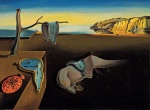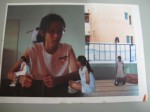After being exposed to surrealism, I decided to look into the surrealistic art and explore deeper.
Surrealism is an anti‐rational movement of imaginative liberation in European (mainly French) art and literature in the 1920s and 1930s, launched by André Breton in his Manifeste du Surréalisme (1924) after his break from the Dada group in 1922. The term surréaliste had been used by the French poet Guillaume Apollinaire in 1917 to indicate an attempt to reach beyond the limits of the ‘real’.
Surrealism seeks to break down the boundaries between rationality and irrationality, exploring the resources and revolutionary energies of dreams, hallucinations, and sexual desire. Influenced both by the Symbolists and by Sigmund Freud’s theories of the unconscious, the surrealists experimented with automatic writing and with the free association of random images brought together in surprising juxtaposition. Although surrealist painting is better known, a significant tradition of surrealist poetry established itself in France, in the work of Breton, Paul Éluard, Louis Aragon, and Benjamin Péret.
Surrealism also attempted to become an international revolutionary movement, associated for a while with the Communist International. Although dissolved as a coherent movement by the end of the 1930s, its tradition has survived in many forms of post‐war experimental writing, from the theatre of the absurd to the songs of Bob Dylan. The adjectives surreal and surrealistic are often used in a loose sense to refer to any bizarre imaginative effect.
Examples of Surrealists:
Salvador Dalí

Dalí was a skilled draftsman, best known for the striking and bizarre images in his surrealist work. His painting skills are often attributed to the influence of Renaissance masters.His best-known work, The Persistence of Memory, was completed in 1931. Dalí’s expansive artistic repertoire includes film, sculpture, and photography, in collaboration with a range of artists in a variety of media.
The Persistence of Memory
The well-known surrealistic piece introduced the image of the soft melting pocket watch. It epitomizes Dalí’s theory of ‘softness’ and ‘hardness’, which was central to his thinking at the time. Many also consider that the melting watches were there to literally symbolize the irrelevance of time.
I think this piece is interesting. But personally, I do not this piece. I think that this painting is quite abstract and hard to understand, and i prefer paintings that explicitly expresses its theme. However, that is just my personal preference and opinion, please feel free to rebut. I do think this piece is well done and the idea of clocks being so soft and jelly is quite interesting. Staring at the whole picture gives me a serene feeling. Well, I think I can explore more artists’ works and perhaps, learn to appreciate yet another form of art.
Acknowledgements to:
http://www.answers.com/topic/surrealism
http://en.wikipedia.org/wiki/Salvador_Dal%C3%AD
http://www.where.ca/travel/index.php/toronto/2009/05/09/ago-surreal-things/



Your SAY!